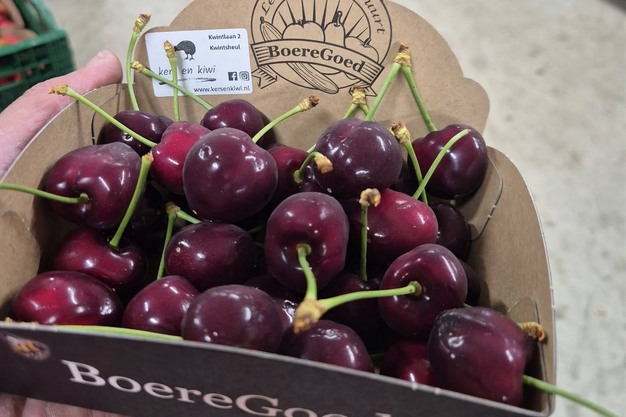 Last Saturday, René and Gerda Arkesteijn harvested their first batch of greenhouse cherries in Kwintsheul. Previously, they grew ornamental plants like amaryllis, but they stopped due to the Dutch energy crisis. What began as a simple hobby quickly expanded, says René, and their 9,000-square-meter greenhouse is now filled with kiwis and cherries. "Last year, we didn't have many cherries, but this year, we have a lot more. People who bought cherries from us last year are already coming back for more."
Last Saturday, René and Gerda Arkesteijn harvested their first batch of greenhouse cherries in Kwintsheul. Previously, they grew ornamental plants like amaryllis, but they stopped due to the Dutch energy crisis. What began as a simple hobby quickly expanded, says René, and their 9,000-square-meter greenhouse is now filled with kiwis and cherries. "Last year, we didn't have many cherries, but this year, we have a lot more. People who bought cherries from us last year are already coming back for more."
For greenhouse cherries, home sales work very well, say the Westland growers, who also supply cherries to BoereGoed. In Kwintsheul, they cultivate 11 different varieties, each offering a unique flavor. The main types they grow are Areko, Sweet Areana, and Prim3.1. "People often stop when they see our cherries," they say. "Cherries are very popular, and they're easy to snack on straight from the container while driving."
Photo right: the first greenhouse cherries of the season
Both the cherries and kiwis are cultivated on trees. Therefore, it takes 7 years for the trees to be in full production. The kiwi trees in the greenhouse in Kwintsheul, René obtained from Italy after he stopped an amaryllis grower. The choice fell on the green type Actinidia Deliciosa Harward. "I already had two kiwi trees in my flower garden. When I was in Italy anyway, I took more trees than I had initially planned under the motto 'since we're here', laughs René.
Both cherries and kiwis are grown on trees, which means it takes about 7 years for the trees to reach full production. After René stopped growing amaryllis, he acquired kiwi trees from Italy for their greenhouse in Kwintsheul. They chose the green variety, Actinidia Deliciosa Harward. "I already had two kiwi trees in my flower garden," René says. "While in Italy, I decided to bring back more trees than I originally intended," he laughs.

Kiwi trees in the greenhouse, early April
Unique with greenhouse-grown kiwis
Last winter, they harvested their first kiwis, which were available from December to early February on Kwintlaan in Kwintsheul. Selling directly to locals helps them gauge demand. "We're figuring out our own approach with the kiwis." Back in 2023, René and Gerda visited New Zealand in order to learn more about Kiwi cultivation in a nation that is pivotal in the kiwi market. This aided the growers tremendously, as the feedback from the first harvest has been positive.
The advantages of greenhouse cultivation
The kiwi cultivation takes up more than half of the greenhouse space, while René grows cherries on just under 3000 square meters. Greenhouse cherry cultivation is more common in the Netherlands than kiwi cultivation (there is only a single other kiwi grower in the entire country), but there aren't many growers in the region."I am part of a study group that includes eight greenhouse cherry growers from across the Netherlands, along with a cultivation advisor," René tells us.
 The benefit of growing cherries in a greenhouse is the earlier harvest. "We start picking our greenhouse cherries about four weeks before those grown outdoors, although outdoor cultivation is also moving quickly this year because of the good weather." After stopping the amaryllis cultivation, they turned off the heating in the greenhouse; their kiwis and cherries are now grown in an unheated greenhouse that still offers clear advantages over outdoor cultivation. "The kiwi trees in my flower garden haven't bloomed yet, but in the greenhouse, the fruits are already a few centimeters big. That shows the difference clearly."
The benefit of growing cherries in a greenhouse is the earlier harvest. "We start picking our greenhouse cherries about four weeks before those grown outdoors, although outdoor cultivation is also moving quickly this year because of the good weather." After stopping the amaryllis cultivation, they turned off the heating in the greenhouse; their kiwis and cherries are now grown in an unheated greenhouse that still offers clear advantages over outdoor cultivation. "The kiwi trees in my flower garden haven't bloomed yet, but in the greenhouse, the fruits are already a few centimeters big. That shows the difference clearly."
In the cherry growers' study group, the Suzuki fly is a frequent topic of discussion, especially since it gets a lot of media attention. Fortunately, this isn't a major concern for René and Gerda's business, Kers en Kiwi. "We're not in a typical cherry-growing area, and there's hardly any fruit cultivation in Westland, which puts us in a good position regarding the Suzuki fly. Additionally, growing in a greenhouse helps because the Suzuki fly doesn't fly very high and isn't likely to enter our greenhouse. Thankfully, we haven't had any issues," says the Westland grower, knocking on wood.
Photo right: kiwi trees in bloom, late April
 Cherries from Kers en Kiwi for sale at BoereGoed
Cherries from Kers en Kiwi for sale at BoereGoed
Challenge
To increase awareness about their products, Kers en Kiwi has started using Facebook and launched a website. On Facebook, the growers frequently share updates, including photos of one of their beehives, with the note: "We have also become beekeepers."
René and Gerda mainly find the challenge in mastering greenhouse kiwi cultivation. "You can't build a new greenhouse for these crops, but this way we can continue for many years."
For more information:
Kers en Kiwi
[email protected]
www.kersenkiwi.nl
